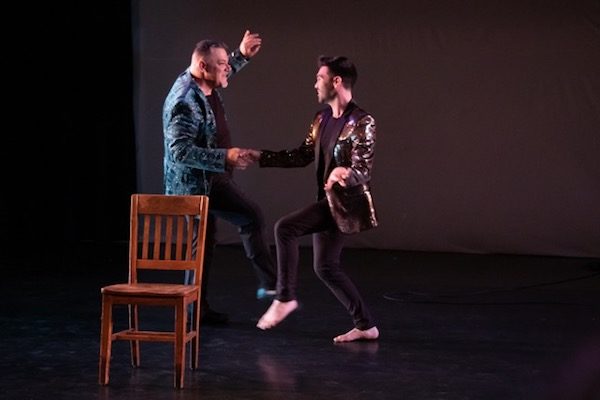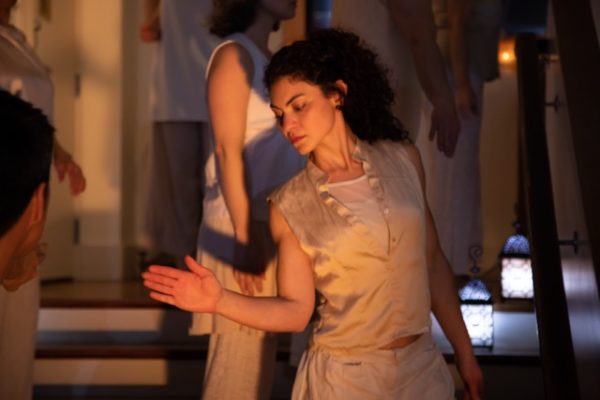Dance Review: “Significant Others: Dances for Family, Friends and Lovers” — Through the Lens of History
By Jessica Lockhart
In this piece, Peter DiMuro asks a vital question: how has history informed the ways we look at queerness today?
Significant Others: Dances for Family, Friends and Lovers, Peter DiMuro/Public Displays of Motion in the Calderwood Pavilion at the Boston Center for the Arts, Martin Hall, Boston, MA (closed)

(l to r) Peter DiMuro and J Michael Winward in a scene from “Significant Others.” Photo: Timothy Avery.
Boston-based artist Peter DiMuro has put together a dance performance that explores his decades of studying gay lives and identities through movement and storytelling. For over 30 years, his work has examined family dynamics, and in Significant Others taps into this history to assist him in dramatizing the depths of love and loss. In this piece, he asks a vital question: how has history informed the ways we look at queerness today?
Significant Others is a collaboration among DiMuro’s Public Displays of Motion, The Bang Group, and J. Michael Winward. Each group is very different in terms of their styles, but it was this very discord that made the evening’s premise work. The stories are similar, but they are told through radically different approaches. This diversity results in an experience that ping ponged ironically: abstract gestures were used to signify loss, family letters were read aloud, skilled dancers presented an exhilarating variety of distinctive visions of love.
DiMuro walked on stage carrying a chair and a cocktail. The lighting created a square room. He took sips from the drink as he outlined the boundaries of his space using arm gestures to indicate a corner, and then repeated that for each corner. He began to read “Dad’s Letter” from 1989. DiMuro moved gently when he read the man’s mundane opening, “the weather is cool and I’m busy boiling potatoes.” But he stopped when his body twitched. As his father’s letter moves into discordant comments about his job and wife, DiMuro’s increasingly repetitive motion becomes frenzied, reflecting the anguish he feels on recounting this unhinged personal account. Another excerpt comes from 1990’s Light Reading, which featured a number of DiMuro’s personal letters. Five women present “Donna.” They sit in a row of chairs listening to each other as each takes turns reading a letter from the DiMuro’s sister. As one performer read, another danced an abstract response to the words. These family letters were anything but light: they reminded us of how complex family relationships can be.
Then, via a change of dynamics, J. Michael Winward’s Hail Mary, Cha cha cha! presented a funny and poignant look at being a queer Catholic teenager. His engaging dialogue featured stories about nuns before some welcome comic relief: he recited traditional Catholic prayers while doing ballroom dance. Winward is a strong performer with terrific timing and considerable presence.

Kara Filli in a scene from “Significant Others.” Photo: Timothy Avery.
The evening’s highlight were three dances performed by The Bang Group. The rhythm-driven company is based in N.Y.C. and it has a long history of teaming-up with DiMuro. First up was a solo, “Octandre,” originally choreographed in 1958 by James Waring. It was performed by Nic Petry: it was an unsettling look at a man being driven to move by dissonant sounds. He struggles to perform traditional ballet jumps and turns, but he is ‘weighed down’ by dark, unseen forces. Watching the performance of this piece, now sixty years old, clearly showed why Waring has been described as “one of dance’s great eccentrics,” an artist who was a pivotal part of experimental movement in the ’50s and ’60s.
Next, “Enough,” which featured a quartet that burst onto the stage with such vibrancy that it almost took my breath away. First the dancers generated a whirlwind, their bodies soaring though the space. Then the mood subtly changed, the mood becoming quiet, a scene of partnering and embracing. Eventually, the dancers kissed — first her, then him, and then all the performers kissing each other. Bright red jackets and skirts were worn by both female and male dancers. The company’s technical virtuosity, marked by movements surprising and bold, was a joy to watch. The performers were Louise Benkelman, Jeffrey Kazin, Tommy Seibold, and Amber Sloan. The next dance was a playful duet, “Tender Traps,” performed to a campy collection of songs sung by Doris Day, Debbie Reynolds, and Frank Sinatra. The unexpected partnering in this dance was a delight.
DiMuro has been present through a considerable amount of history: from the AIDS crisis to the battles for gay marriage and transgender rights. Significant Others suggests that he isn’t showing any signs of slowing down, and that’s reassuring. In an increasingly fragmenting culture, we need artists who shed light on what makes us all human, different, and yet very much alike.
Jessica Lockhart is a National Endowment for the Arts Fellow in Dance Criticism and has a BA in Communication from the University of Southern Maine. Lockhart is a Maine Association of Broadcasters award winning independent journalist. Currently, she also works as program director at WMPG Community radio.
Tagged: Friends and Lovers, Jessica Lockhart, Peter, Peter DiMuro, Peter DiMuro/Public Displays of Motion

So glad to read this review! Tho a gay man involved in dance for many years, I don’t know much about “gay dance.” Peter and Michael inspired me to go to the Queerly Dance Festival. They, that event, and this article inspire me even further to see if I can set up a residency between what they’re doing in the Boston-Cambridge area and Mexico City’s Queer Dance Festival at my Tlacopac Artist Residency there. This is a rare dance review that captures not only what happened, but how it felt to be there.